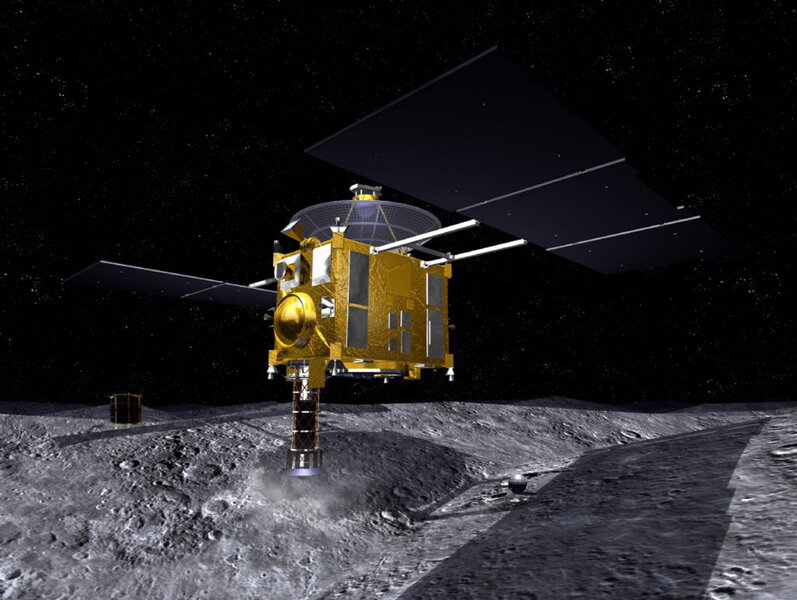Japan tests asteroid-blasting 'space cannon'
Loading...
Japan’s space agency conducted a successful test this week of its “space cannon,” expected to depart on a mission to shoot an asteroid in 2014, as part of the Hayabusa 2 mission.
The Japan Aerospace Exploration Agency (JAXA) plans to launch space probe Hayabusa 2 to an asteroid next year, in hopes of sampling a class of asteroids expected to be rich in organic materials. The mission is expected to help astronomers better understand the relationship between asteroid organic materials and those found on Earth, as well as to burnish Japan’s reputation as a top space explorer.
The news comes just one month after JAXA launched into space its Epsilon rocket, a cost-effective rocket that runs on automated systems, not human operators. The rocket has been billed as heralding a new generation of high-tech spacecraft, along with Japan’s reentry to the forefront of Earth’s foray into the final frontier, after decades of intermittent space flops.
In 1970, Japan had become the third country to put a satellite in space, after the United States and the former Soviet Union. But, since then, the island nation has had a checkered relationship with space exploration, the New York Times reported in 2010.
Japan has never put a person in space, though it has an ongoing manned spaceflight program, with the hope of launching an astronaut in 2025. Japan’s Akatsuki probe, slated to orbit Venus, missed the piping hot planet two years ago and veered for the sun. Two Japanese satellites were lost in just three months in 2000. A 1998 probe launched for Mars missed the Red Planet.
The latest project, Hayabusa 2, is not an asteroid destruction mission – unlike the planet-destroying Death Star in ‘Star Wars,’ Hayabusa 2 is not primed to boom a giant hunk of rock out of existence. Instead, the probe’s so-called cannon is intended to put an artificial crater into the target, the C-type asteroid 1999 JU3, with a 4-pound projectile, exposing subsurface material. Hayabusa 2, which will have detached from the canon and gone to “hide behind the asteroid” while the cannon does the explosive work, will then sample the material, believed to be rich in water and organic matter.
The craft, set to depart in 2014, is expected to reach the asteroid in June 2018. It is due to return to Earth in December 2020.
Three years ago, Japan’s first iteration of the probe, the Hayabusa (“falcon,” in Japanese), made the first ever round-trip mission to an asteroid. Its seven-year trip to and from the Itokawa asteroid, a member of the common S-type of asteroids, brought back for Japan samples that would go on to answer an outstanding question in astronomy: why don’t meteorites that fall to Earth appear to come from the asteroid belt?
Well, it turns out they do, reported Hayabusa. Based on remote recordings of asteroid’s spectral colors, astronomers had once though that S-type asteroids were too red to be the source of meteorites. But, the Hayabusa team reported, the solar wind had been responsible for distorting the observed colors of asteroids – S-types were not so red, after all. In fact, Hayabusa’s asteroid dust samples turned out to be a compositional match to meteorites. Case closed.
In 2011, the scientific journal Science named the Hayabusa one of the year’s scientific breakthroughs. But it was a mission not without pitfalls. Before Hayabusa touched down and unfurled its asteroid samples, the world had been prepared to call the mission an abject failure.
As Hayabusa headed for the asteroid, the spacecraft lost two of its three attitude-controlling wheels, accidently deployed into deep space the small rover that had been meant to tour the asteroid’s surface, and struggled to touch down on the asteroid. En route home, things went from bad to worse. The craft short-circuited. It sprung a fuel leak. It lost communication with Earth.
When Hayabusa’s baseball-sized sample capsule did drop to Earth, to everyone’s surprise, it was three years late. JAXA at first reported that there was nothing inside: no asteroid samples, it appeared, had even been collected.
Of course, everything turned out just fine: Hayabusa had collected about 100 tiny particles from the asteroid. But JAXA is taking no chances with Hayabusa 2. The agency reports that problems identified in the craft’s predecessor have been identified and mended. It also says that Hayabusa 2 will have one advantage Hayabusa didn’t get: letters from home.
In collaboration with the Planetary Society, JAXA is attaching chips full of “support messages” from earthlings to the craft. The project is called “Let’s meet with Le Petit Prince!,” in homage to Antoine de Saint-Exupéry’s 1943 novella about a celestial royal fallen to Earth from a small asteroid.
Meanwhile, NASA has hatched plans to send its own robotic capture vehicle to an asteroid in 2018, bag it up, and then send a manned spacecraft to sample it. If the project goes forward – the plan to snag an asteroid has encountered political snags in Congress – it would be the first manned mission an asteroid.








